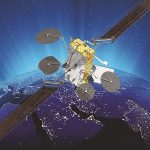Plagued by poor connectivity and low bandwidth in a shaky political set-up, Sudan has never really managed to rise to its full potential. Local satellite operator Sudasat hopes to change the game with the introduction of Ka-band services, which it says will bring higher speeds at lower costs to more people, setting the stage for a better economy. In an exclusive interview with Vijaya Cherian, Sudasat GM Khalid Ehaimer unveils whats in store come November.

A new dawn awaits Sudan as Sudasat, the country’s largest VSAT operator, looks to fuel the nation’s growth trajectory and enhance connectivity in East Africa with customised products at competitive prices. To execute that vision, Sudasat recently entered into a partnership with Arabsat that will allow it to use the Ka-band transponders on the newly launched Arabsat 6A satellite, to provide broadband communications and services across Sudan to enterprises and telcos at much higher speeds than in the past. This service is due to launch on November 1, 2019.
“With the introduction of Ka-band, we intend to change how business is done in Sudan,” says Sudasat General Manager Khalid Ehaimer, who has been tasked with transforming Sudasat and bringing it on a par with the current era.
“By having Ka- along with C- and Ku-band, we hope to have a wider range of services for our customers. We don’t just want to be a service provider; we want to be known as a VSAT network operator,” he clarifies.
“We have active mining and agricultural ecosystems, and we are trying to offer solutions that are relevant to Sudan’s context,” Khalid Ehaimer, GM, Sudasat.
A big part of this vision is Sudasat’s teleport facility at Umm Haraz satellite station, which is currently being upgraded and is scheduled to be operational by the end of October. The teleport will also support the satellite ground station services for global satellite operators.
Sudasat is a young company by global standards. As a result of a joint venture between Sudatel and Haggar Holding Company, Sudasat was set up in 2006 and provides voice and data connectivity. At present, only 40% of Sudan’s population is connected; although mobile operators claim to cover 90% of the country, what they actually cover is 90% of the urban areas, says Ehaimer.
For instance, regions like Darfur and eastern Sudan are only well connected in populated areas. Likewise, the northwestern part of Sudan has until recently been devoid of people and connectivity has not been necessary. However, its gold and oil reserves are now attracting public and private entities and new job opportunities for civilians. Connectivity will become essential soon.
“We hope to reach 100% of the Sudanese population and offer services at a third of the existing price”, Khalid Ehaimer, GM, Sudasat.
 A considerable chunk of Sudasat’s business will also include enhancing broadcast services. Sudan has 30 TV channels, 18 of them broadcast from Jordan. The aim is to build the infrastructure within the country: “We have big plans to bring all African channels to be broadcast from Sudan,” says Ehaimer.
A considerable chunk of Sudasat’s business will also include enhancing broadcast services. Sudan has 30 TV channels, 18 of them broadcast from Jordan. The aim is to build the infrastructure within the country: “We have big plans to bring all African channels to be broadcast from Sudan,” says Ehaimer.
All this will become possible with Arabsat-6A, a high-capacity telecommunications satellite poised to deliver television, radio, internet and mobile communications to customers in the Middle East, Africa and Europe. Built on Lockheed Martin’s enhanced LM 2100 platform, Arabsat-6A provides advanced Ka spot-beam communications services. Sudasat, in partnership with Canar Telecom, witnessed its launch at its orbital position 30.5 earlier this year.
“Ka is an evolution and can be managed through cheaper and smaller terminals. Through Ka, we will be able to reach areas that couldn’t be reached before, including northwest Sudan. We hope to reach 100% of the Sudanese population and offer services at a third of the existing price,” Ehaimer explains.
So far, Sudasat has had only two services for its customers: shared and dedicated networks. With the new partnership, 12 services are in the offing, with the first of these to be rolled out in November. One of these is WiFiSAT, a service aimed at rural areas. Sudasat will provide connectivity over satellite while last-mile distribution will be through WiFi, as that requires no additional investment.
“The small size of the terminal and the flexibility to introduce different applications makes Ka-band very attractive,” Khalid Ehaimer, GM, Sudasat.
 ProSAT, a second service targeting professional entities, enterprises and NGOs, which comes bundled with solutions like CCTV and IP phone services, will also be launched.
ProSAT, a second service targeting professional entities, enterprises and NGOs, which comes bundled with solutions like CCTV and IP phone services, will also be launched.
Also to be rolled out on Ka-band are VoIPSAT; NomadSAT, a portable solution; HomeSAT, a triple play service with internet, VOD, VoIP and IPTV in a set-top box; GoSAT, a connectivity service for aircraft, vessels, trains and the like; SiteSAT, which includes a tower, green power and GSM designed specifically as low-cost sites for Universal Service Fund; and GeoSAT for satellite imaging.
One service that Ehaimer is betting on is IoTSAT, which will cater to communities working in agriculture and mining- two ecosystems that are the heartbeat of Sudan’s economy. “We have active mining and agricultural ecosystems, and we are trying to offer solutions that are relevant to Sudan’s context. We believe this will be hugely successful and will be one of our first new product offerings,” he confides.
Another new product scheduled for launch is CastSAT, a TV broadcasting service over Ku, while two new services- HaulSAT for backhauling and DrySAT for operators outside Sudan- will be available on C-band. HaulSAT will also be available on Ka-band.
“We will start with WiFiSAT, ProSAT, VoIPSAT, IoTSAT, NomadSAT and GoSAT. Some of these will be rolled out in October. Testing and POCs for others will begin in October, and official roll-outs will begin in November for those,” explains Ehaimer.
A chunk of these services will rely on Arabsat-6A’s Ka-band spot beam, which promises to offer business enterprises in Sudan more bandwidth and stable connectivity at a much lower cost.
 “Arabsat-6A includes many sophisticated services that make it the most up-to-date satellite, effective, flexible and versatile, as it has a high capacity and provides digital broadcasting, telecommunications and internet services to the customers in Sudan. We hope to leverage these aspects and capacities of the satellite to rediscover how space communication technologies can impact Sudan and its people,” says Ehaimer.
“Arabsat-6A includes many sophisticated services that make it the most up-to-date satellite, effective, flexible and versatile, as it has a high capacity and provides digital broadcasting, telecommunications and internet services to the customers in Sudan. We hope to leverage these aspects and capacities of the satellite to rediscover how space communication technologies can impact Sudan and its people,” says Ehaimer.
WiFiSAT, for instance, is ideal for villages and people in remote areas.
“We couldn’t roll this out before with C-band, because it was an expensive proposition. C-band is, first of all, a limited resource, and the nature of the technology makes it more expensive. The maintenance of a C-band satellite is huge for an operator and the cost per Mhz is very high. C-band does cover a much larger footprint than Ka-band, but the capacity is also spread out, so bandwidth is limited,” he explains.
“By comparison, with Ka, the small size of the terminal and the flexibility to introduce different applications makes it very attractive. Also, the internet is not just for entertainment; today, it significantly aids in improving people’s lives. If we can provide internet services to UN agencies and border security forces, imagine what they can do. It’s all about connectivity, and having bandwidth is a huge opportunity by itself.”
With Ka-band, more CCTV and teleservice opportunities will open up, and Sudasat is partnering with application companies to ensure this. Its strategy is to deploy Ka-band while retaining its services on the other two bands. C-band is significant in some areas of Africa that have regular rains, but the new offerings will help Sudasat reach other parts of East Africa as well.
“While there are no market agency reports that can evaluate the size of the satellite industry in Sudan, our own internal research shows us that Sudasat occupies 60-70% of the market, followed by Canar Telecommunications and others. We hope to capitalise on our foothold with the introduction of Ka-band, but Ka-band is primarily for operations inside Sudan. Services to other countries will largely require C-band.”
Sudasat also hopes to ensure greater connectivity in places like Eritrea, Mauritania and Senegal, and to diversify its operations to be an end-to-end service provider.
But the ride is not without its challenges. Sudasat is inching closer to facilitating greater connectivity with partnerships, but a critical element in this mix is funding, often hard to come by. This is why Sudasat did not consider launching its own satellite, deciding to go with a stable partner like Arabsat instead. Preparing the ground infrastructure to take Sudasat’s vision forward will require considerable investment, and the company is in talks with banks and financial institutions to secure funding for its business and to support its research and development arm.
In parallel, Sudasat is working closely with universities and technical institutions in Sudan to create new programmes to train and nurture a new generation of youngsters equipped with the knowledge and tools to take Sudan’s space ambitions forward.
“Enablement through partnerships is our way to grow. We believe that partners can bring a lot of ideas and expertise to Sudasat, and that is why we are teaming up with incubators and small businesses to further our growth story. Some of our partners include Newtec, IDirect and Cetel, and we are looking forward to bringing in more expertise through these partnerships,” remarks Ehaimer.
While he is positive that Ka-band will bring greater connectivity to Sudan, we will have to wait and watch to see how satellite technologies will change the data dynamics in a country with only about 40% of its populace currently covered. Ehaimer, however, is hopeful about the future.
“We are a nation of dreamers and believers, and we have the talent. Sudan is like an African lion, waiting to seize every opportunity that comes its way. Despite the political instability, the country and Sudasat have shown tremendous resilience and we are certain that a time will come when our dreams come alive.”












































































